From a tiny Northern Saw-whet Owl in Ripton on January 1st to a Snowy Owl on the Burlington Waterfront on New Year’s Eve, Vermont birders scoured fields and fens, mountains and meadows, lakes and lawns to discover as many bird species as possible during the 8th annual Vermont eBird County Quest.
The annual year-long contest pits county versus county, birder against birder — all engaged in a friendly rivalry for top birding honors. The main idea behind the year-long Quest is simply to get people out birding, promote camaraderie, and better document bird life across the state, using Vermont eBird.
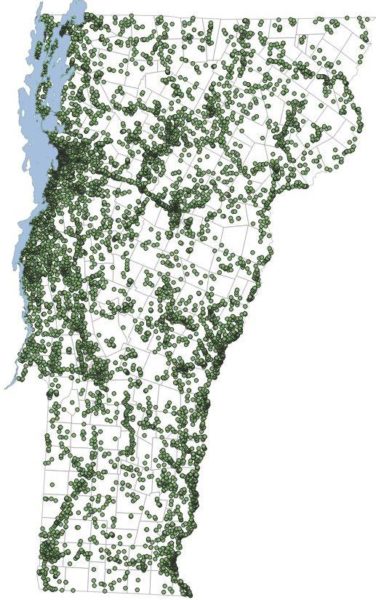
Vermont eBirders submitted checklists from over 10,000 locations representing nearly every town in Vermont in 2018.
2018 marked the 15th year for Vermont eBird, the first state or provincial portal for eBird. In just a decade-and-a-half, the checklists that bird watchers have shared have helped make Vermont eBird, a project of the Vermont Atlas of Life, the largest citizen science biodiversity project in the state and around the world. 7,460 Vermont eBirders have submitted nearly 311,000 complete checklists, representing all 384 species of birds ever reported from Vermont. We’ve added nearly 50,000 images and over 2,500 sound recordings to Vermont checklists creating an incredible open access resource.
And, of course, it isn’t all just for fun. Its for science and conservation too. This year we were excited to announce a huge advance in the understanding of birds, only made possible with eBird data. The bird observations submitted by you and many others contribute to these exciting new results: your eBird checklists are now working even harder to advance science and our knowledge of birds. The result of all this hard work is eBird Status and Trends—detailed population information for over 100 species of North American birds, providing an unprecedented depth of information in four key areas:
- Abundance maps, like this one for Cedar Waxwing
- 10-year population trend maps, Wood Thrush for example, which appears to be declining across the state.
- Habitat association charts, shown here for Magnolia Warbler in Vermont.
- Range maps, shown here for Red-winged Blackbird.
Green Mountain eBirders Put Up SUPER Big Numbers in 2018
With 46,396 complete checklists submitted to Vermont eBird, comprising 591,638 bird records, representing 278 bird species, and tallied by over 2,125 Vermont eBirders in 2018, there is no doubt it was another banner year for birders and Vermont eBird.
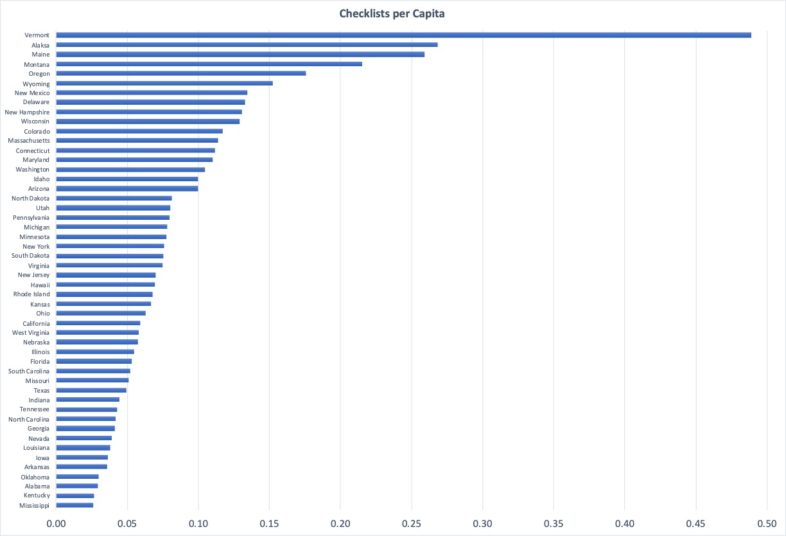
Vermont eBirders lead the nation in the number of complete checklists per capita. Click on the chart to view a larger image.
County Cup Champions
Chittenden County, always a contender but never a winner, until now. Congratulations to all the birders who helped the county claim the 2018 Quest Cup with a score of 28.5 birds over par. Windsor County was the runner up missing the cup by just one-half bird with 28 birds over par.
The County Cup award is based on a carefully calculated “par” system, realizing that not all Vermont counties are created equal in terms of avian diversity. Par scores reflect the number of species that a given county should find in a year with consistent birding effort. Each year a particular county wins, 5 birds are added to their par.
Rich in birders and species, Chittenden County had the highest number of bird species found (250), tying the all-time record for a county (Addison in 2011). Their perennial rival Addison County was second with 244 species.
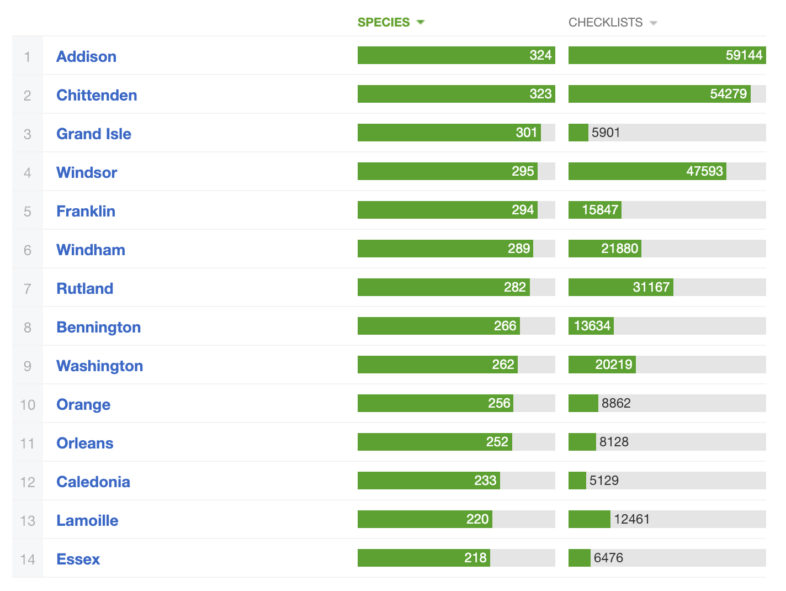
All-time tally of bird species and complete checklists by Vermont county. Click on the image to visit Vermont eBird to explore each county.
Individual County Winners
Awarded to the birders with the most checklists for each county and to the birders with the highest species count for each county. No par or weighting necessary for this one!
Visit the Vermont eBird Top 100 list to get a full tally of Checklist and Species List Champions for any year. Simply select the county you are interested in, then on the next page select the year you would like to see in the upper right corner.
Statewide Winners
Many birders ventured outside their home county of course. Jim Mead continued his dominance in total species observed tying his record of 266 species, followed by Craig Provost (259) and Graham Rice in third (253). A runner up no longer, Craig Provost logged 2,017 complete checklists with the perennial champion Ian Worley placing second with 1,126 complete checklists followed by Jim Mead with 1,002.
The County 150 Club
eBirders who identified 150 species or more in a county are inducted into the prestigious “150 Club”. Even in counties with higher avian diversity, a birder must be dedicated and in the field during all four seasons to join this club. Check out the 150 Club honor roll to see how you and your birding friends have done.
In a remarkable feat, both Fred Pratt and Craig Provost have just two more counties to be the first to attain at least 150 species in one year in all 14 counties. Overall, 118 individual birders have joined the elite 150 Club in at least one county since the Vermont County eBird Quest began in 2011.
The Vermont 250 Club
The Vermont 250 Club requires even more dedication. This is a list of eBirders that have found 250 or more bird species in Vermont during one calendar year and reported them to Vermont eBird. To complete this, birders have to find about 90% of the species found in Vermont in any given year! Jim Mead has passed 250 species 7 times in the last 8 years! This year, four other birders join him.
Cat Abbott (2018)
Zac Cota (2017)
Eddy Edwards (2017)
Bill Mayville (2017)
Mae Mayville (2017)
Jim Mead (2011, 2012, 2014, 2015, 2016, 2017, 2018)
Clem Nilan (2018)
Craig Provost (2018)
Graham Rice (2018)
Alison Wagner (2017)
You can see the entire ranked list for each year by visiting the Vermont eBird Top 100.
Congratulations to everyone for a fun year of birding! We hope some of you will vie for top honors in 2019. You can follow the scoreboard all year long and see where you rank. Even if you come up short, all of the data collected in Vermont eBird is valuable for science, education, and conservation. Good luck eBirding in 2019!
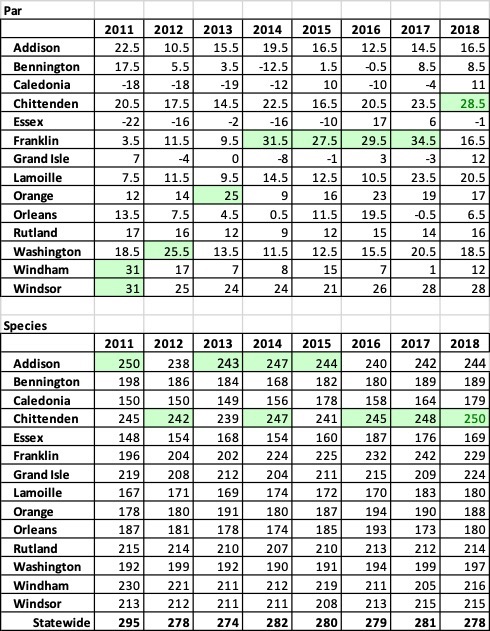

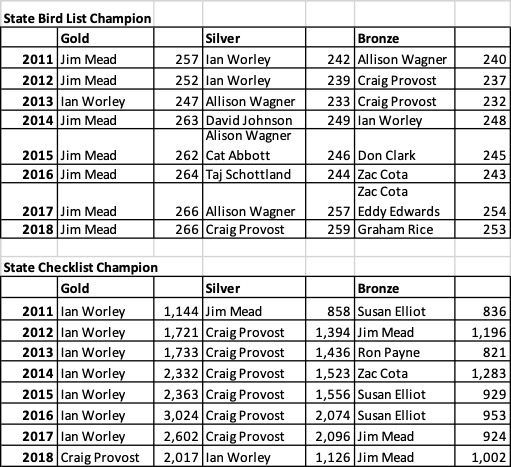

Way to go……………….